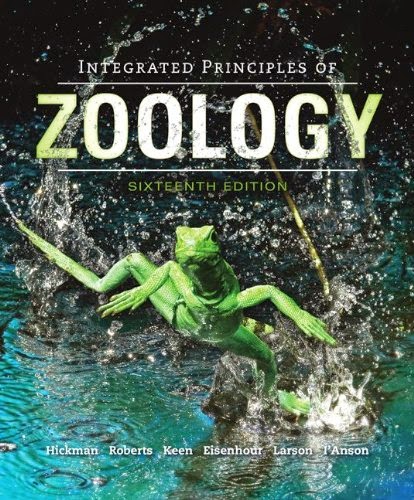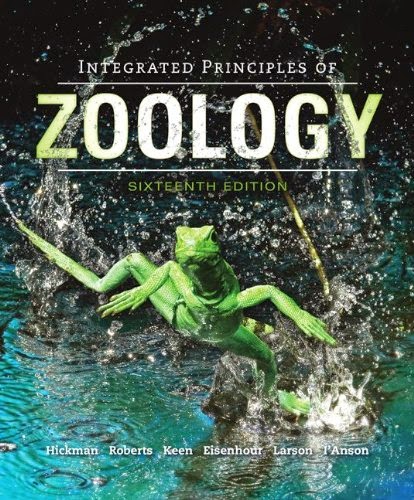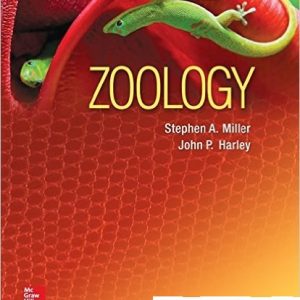Test Bank Integrated Principles of Zoology 16th Edition Hickman Keen Larson Roberts

Product details:
- ISBN-10 : 0073524212
- ISBN-13 : 978-0073524214
- Author: Allan Larson
Description:
Chapter 03
Multiple Choice Questions
- The Dutch microscopist who sent letters to the Royal Society of London describing his many detailed observations of life, including units later known to be cells, was
A.Anton van Leeuwenhoek.
B. Robert Hooke.
C. Matthais Schleiden.
D. J. Purkinje.
Accessibility: Keyboard Navigation
Bloom’s Level: 1. Remember
Gradable: automatic
Section: Cell Concept
Topic: Cell Concept
- Which of the following is NOT true about the Cell Theory?
A.It states that all organisms are composed of cells
B. It states that all cells come from preexisting cells
C. It states that small organisms can arise spontaneously
D. It is accepted today by biologists as applying to virtually all forms of life
Accessibility: Keyboard Navigation
Bloom’s Level: 1. Remember
Gradable: automatic
Section: Cell Concept
Topic: Cell Concept
- The surface of some parasitic flatworms and some insect tissues is a “syncytium” or living layer that contains many nuclei and cell organelles but is not partitioned by plasma membranes. These tissues consume food, respire, and produce wastes. Since the cell theory states that “all living things are composed of cells” what is the best statement to accompany this question?
A. These tissues are not living because they are not cellular
B. These tissues are obviously a bridge between nonliving and primitive living cells
C. The general concept of “life is cellular” still holds because these organisms still utilize cells sometime in their life, but this shows that plasma membrane partitions can be abandoned in some animals
D. This proves that a “vital force” beyond cell chemistry gives life to substances
Accessibility: Keyboard Navigation
Bloom’s Level: 4. Analyze
Gradable: automatic
Section: Cell Concept
Topic: Cell Concept
- A high-powered microscope that produces a surface image from scattered secondary electrons is the
A. brightfield light microscope.
B. transmission electron microscope (TEM).
C. scanning electron microscope (SEM).
D. confocal microscope.
Accessibility: Keyboard Navigation
Bloom’s Level: 1. Remember
Gradable: automatic
Section: Cell Concept
Topic: Cell Concept
- An important technique that allows biologists to trace the fate of chemicals in metabolic pathways is the use
A. of the immunofluorescence microscope.
B. of radioactive isotopes.
C. of time lapse photography.
D. of centrifugation.
Accessibility: Keyboard Navigation
Bloom’s Level: 4. Analyze
Gradable: automatic
Section: Cell Concept
Topic: Cell Concept
- The current theory of the structure of the plasma membrane is best described by which of the following models.
A.The fluid-mosaic model
B. The unit membrane model
C. The electrochemical model
D. The nuclear envelope model
Accessibility: Keyboard Navigation
Bloom’s Level: 1. Remember
Gradable: automatic
Section: Organization of Cells
Topic: Organization of Cells
- Major functions of the plasma membrane do NOT include
A. regulating molecules and ions that pass into and out of the cell.
B. recognizing and communicating between different cells and tissues.
C. maintaining connections between adjacent cells.
D. producing proteins used in construction of the cell.
Accessibility: Keyboard Navigation
Bloom’s Level: 2. Understand
Gradable: automatic
Section: Organization of Cells
Topic: Organization of Cells
- In a phospholipid bilayer, the
A.Cholesterol is on the outside and plays a critical role in maintaining the fluidity of the membrane
B. Glycoproteins are on the inside providing a supporting site for adhesive functions
C. Glycoproteins are anchored in the plasma membrane to assist in their transport functions
D. Water-soluble ends are oriented toward the exterior and interior of the cell, whereas the fat-soluble fatty acids are oriented toward the inside of the membrane
Accessibility: Keyboard Navigation
Bloom’s Level: 1. Remember
Gradable: automatic
Section: Organization of Cells
Topic: Organization of Cells
- Biologists label various carbohydrates, fats and amino acids with radio-isotopes, place them in a cell culture, and allow time for cell metabolism. Then by disrupting cells in a blender and separating out various cell organelles, they find the radioactive molecules can be detected as part of various cellular compounds although visible cell structures appear unchanged. Therefore
A. these “food” molecules are used only for energy.
B. most cell components are constantly being broken down and rebuilt.
C. molecules diffuse at random through the cytoplasm and into cell organelles.
D. radioactivity has an unusual role in metabolism of living cells.
Accessibility: Keyboard Navigation
Bloom’s Level: 2. Understand
Gradable: automatic
Section: Cell Concept
Section: Organization of Cells
Topic: Cell Concept
Topic: Organization of Cells
- Which correctly describes ribosomes?
A.Ribosomes contain both DNA and protein
B. Ribosomes are active in carbohydrate synthesis
C. Ribosomal subunits leave the nucleolus and form ribosomes in the cytoplasm
D. Ribosomes are found associated with the endoplasmic reticulum in prokaryotic cells
Accessibility: Keyboard Navigation
Bloom’s Level: 2. Understand
Gradable: automatic
Section: Organization of Cells
Topic: Organization of Cells
- Which is true concerning the Golgi complex?
A.It consists of a stack of membranous vesicles
B. Golgi complexes in animal cells have a forming face and a maturing face
C. Lysosomes are enzyme-filled vesicles that bud from the Golgi complex
D. All of the choices are correct
Accessibility: Keyboard Navigation
Bloom’s Level: 2. Understand
Gradable: automatic
Section: Organization of Cells
Topic: Organization of Cells
- When water in a cell freezes slowly, sharp crystals spear through the membranes of the cell. The most likely explanation for the bad taste of meat that has “freezer burn” from repeated freeze/thaw cycles is the destruction of
A. the Golgi bodies and their vesicles.
B. lysosomes and resultant autodigestion.
C. rough endoplasmic reticulum causing the release of ribosomes.
D. the nuclear membrane causing mixing of nucleoplasm and cytoplasm.
Accessibility: Keyboard Navigation
Bloom’s Level: 3. Apply
Gradable: automatic
Section: Organization of Cells
Topic: Organization of Cells
- Which of the following is a correct statement concerning the comparison of prokaryotic and eukaryotic cells?
A.Mitosis is common to both groups
B. Flagella and cilia of both groups are identical with a “9 + 2” microtubular pattern
C. The DNA nucleoid of a prokaryote is not membrane bound; the nucleus of a eukaryote is membrane bound
D. All of the choices are correct
Accessibility: Keyboard Navigation
Bloom’s Level: 2. Understand
Gradable: automatic
Section: Organization of Cells
Topic: Organization of Cells
- Which of the following is a correct statement comparing prokaryotic and eukaryotic cells?
A.Both must provide for transfer of genetic information
B. Both must have some individuals that reproduce
C. Both must separate their interior world from the external world
D. All of the choices are correct
Accessibility: Keyboard Navigation
Bloom’s Level: 2. Understand
Gradable: automatic
Section: Organization of Cells
Topic: Organization of Cells
- Which is NOT a characteristic of mitochondria?
A.A mitochondrion has two membranes
B. Mitochondria are the site of cellular respiration
C. Mitochondria contain their own genome
D. Mitochondria are replicated by nuclear chromosomes
Accessibility: Keyboard Navigation
Bloom’s Level: 1. Remember
Gradable: automatic
Section: Organization of Cells
Topic: Organization of Cells
- Movement is not only a feature of animal cells but of all eukaryotic cells. Which of the following are involved in a cell’s ability to move?
A.Microtubules
B. Microfilaments
C. Actin and myosin
D. All of the choices are correct
Accessibility: Keyboard Navigation
Bloom’s Level: 1. Remember
Gradable: automatic
Section: Organization of Cells
Topic: Organization of Cells
- Which element is NOT correctly associated with its structures and function?
A.Cilia have 9 pair of microtubules surrounding a central pair
B. Microtubules are made up of a protein called tubulin
C. Pseudopodia stream without the involvement of any microfilaments
D. Centrioles have a microtubule structure
Accessibility: Keyboard Navigation
Bloom’s Level: 2. Understand
Gradable: automatic
Section: Organization of Cells
Topic: Organization of Cells
- The best definition of diffusion is
A. movement of molecules from higher concentration to lower concentration.
B. movement of water across a semi-permeable membrane from high water concentration to lower water concentration.
C. movement of molecules from lower concentration to higher concentration.
D. movement of a substance against its concentration through the release of energy from ATP.
Accessibility: Keyboard Navigation
Bloom’s Level: 1. Remember
Gradable: automatic
Section: Organization of Cells
Topic: Organization of Cells
- Technically, osmosis is
A. movement of molecules from higher concentration to lower concentration.
B. movement of water across a semi-permeable membrane from high water concentration to lower water concentration.
C. movement of molecules from lower concentration to higher concentration.
D. movement of water across a semi-permeable membrane from low water concentration to higher water concentration.
E. movement of a substance against its concentration through the release of energy from ATP.
Accessibility: Keyboard Navigation
Bloom’s Level: 2. Understand
Gradable: automatic
Section: Organization of Cells
Topic: Organization of Cells
- Which is the best definition of active transport?
A.Movement of molecules from higher concentration to lower concentration
B. Movement of water across a semi-permeable membrane from high water concentration to lower water concentration
C. Movement of molecules from lower concentration to higher concentration
D. Movement of a substance against its concentration through the release of energy from ATP
Accessibility: Keyboard Navigation
Bloom’s Level: 1. Remember
Gradable: automatic
Section: Organization of Cells
Topic: Organization of Cells
- A paramecium is placed in a hypotonic solution. Which will occur?
A.Salts will move into the paramecium from the surrounding solution
B. Water will move into the paramecium from the surrounding solution
C. Salts will move out of the paramecium into the surrounding solution
D. Water will move out of the paramecium into the surrounding solution
Accessibility: Keyboard Navigation
Bloom’s Level: 3. Apply
Gradable: automatic
Section: Organization of Cells
Topic: Organization of Cells
- If a fish is placed in an isotonic solution, which will occur?
A.Salts will move into the fish from the surrounding solution
B. Water will move into the fish from the surrounding solution
C. Salts will move out of the fish into the surrounding solution
D. Water will move out of the fish into the surrounding solution
E. None of the choices will occur
Accessibility: Keyboard Navigation
Bloom’s Level: 3. Apply
Gradable: automatic
Section: Organization of Cells
Topic: Organization of Cells
- The sodium-potassium pump moves sodium and potassium ions across the plasma membrane by
A. facilitated transport.
B. active transport.
C. cotransport.
D. endocytosis.
Accessibility: Keyboard Navigation
Bloom’s Level: 1. Remember
Gradable: automatic
Section: Organization of Cells
Topic: Organization of Cells
- Sugars and amino acids move into the cell by the sodium-potassium pump by means of
A. facilitated transport.
B. active transport.
C. simple diffusion.
D. endocytosis.
Accessibility: Keyboard Navigation
Bloom’s Level: 1. Remember
Gradable: automatic
Section: Organization of Cells
Topic: Organization of Cells
- The specific form of endocytosis wherein small areas of the surface membrane are invaginated to form tiny vesicles containing fluids.
A.Pinocytosis
B. Cotransport
C. Endocytosis
D. Exocytosis
Accessibility: Keyboard Navigation
Bloom’s Level: 1. Remember
Gradable: automatic
Section: Organization of Cells
Topic: Organization of Cells
- Cell products such as undigested residues are removed from the cell through
A. facilitated transport.
B. cotransport.
C. endocytosis.
D. exocytosis.
Accessibility: Keyboard Navigation
Bloom’s Level: 1. Remember
Gradable: automatic
Section: Organization of Cells
Topic: Organization of Cells
- The two stages of cell division are
A. initiation and completion.
B. duplication of chromosomes and division of chromosomes.
C. mitosis and cytokinesis.
D. None of the choices are correct.
Accessibility: Keyboard Navigation
Bloom’s Level: 1. Remember
Gradable: automatic
Section: Mitosis and Cell Division
Topic: Mitosis and Cell Division
- If the nucleus divides many times without cytokinesis occurring, the result is
A. cell death.
B. interphase.
C. a multinucleate cell.
D. an incomplete spindle.
Accessibility: Keyboard Navigation
Bloom’s Level: 1. Remember
Gradable: automatic
Section: Mitosis and Cell Division
Topic: Mitosis and Cell Division
- Which sequence of stages in mitosis is correct?
A.Prophase, anaphase, metaphase, telophase
B. Prophase, telophase, anaphase, metaphase
C. Prophase, metaphase, anaphase, telophase
D. Anaphase, metaphase, prophase, telophase
Accessibility: Keyboard Navigation
Bloom’s Level: 1. Remember
Gradable: automatic
Section: Mitosis and Cell Division
Topic: Mitosis and Cell Division
- Which occurs during metaphase?
A.Centrioles move to opposite poles
B. Chromosomes line up along the equator of the dividing cell
C. Chromosomes move to opposite poles
D. The nuclear envelope disappears
Accessibility: Keyboard Navigation
Bloom’s Level: 1. Remember
Gradable: automatic
Section: Mitosis and Cell Division
Topic: Mitosis and Cell Division
- Which occurs during anaphase?
A. Centrioles move to opposite poles
B. Chromosomes line up along the equator of the dividing cell
C. Chromatids move to opposite poles
D. The nuclear envelope disappears
Accessibility: Keyboard Navigation
Bloom’s Level: 1. Remember
Gradable: automatic
Section: Mitosis and Cell Division
Topic: Mitosis and Cell Division
- Which does NOT occur in telophase?
A.Cytokinesis is underway
B. Nuclear envelope is reconstructed
C. Centromeres split apart
D. Chromosomes decondense into chromatin
Accessibility: Keyboard Navigation
Bloom’s Level: 2. Understand
Gradable: automatic
Section: Mitosis and Cell Division
Topic: Mitosis and Cell Division
- In most animal cells, the majority of the cell cycle is spent in
A. metaphase.
B. anaphase.
C. interphase.
D. prophase.
Accessibility: Keyboard Navigation
Bloom’s Level: 2. Understand
Gradable: automatic
Section: Mitosis and Cell Division
Topic: Mitosis and Cell Division
People also search:
integrated principles of zoology hickman
integrated zoology courses
integrated principles of zoology 18th edition answers
what is the concept of integrated education
integrated principles of zoology 16th edition





